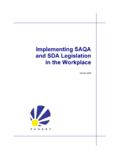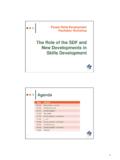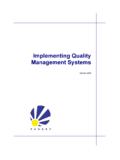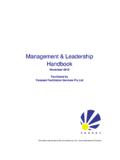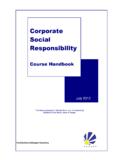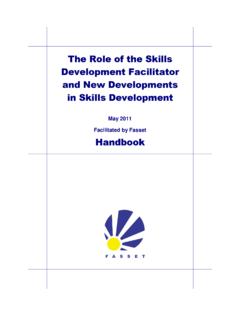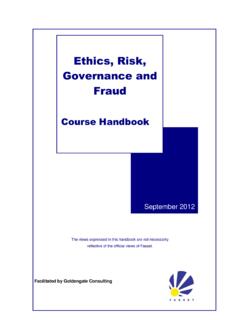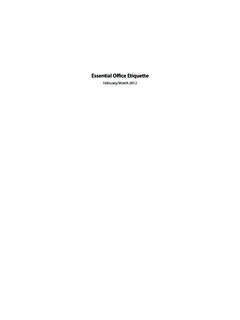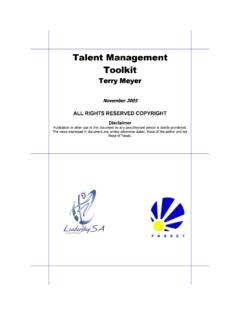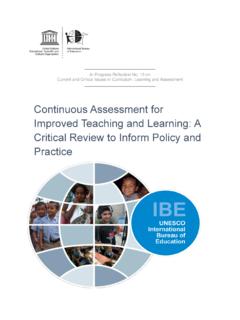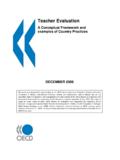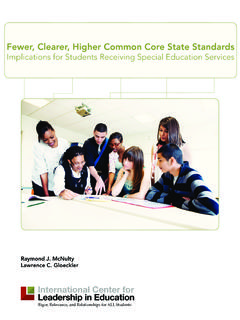Transcription of Implementing and Conducting an Assessment in …
1 Implementing and Conducting an Assessment in the Workplace October 2004 Implementing and Conducting an Assessment in the Workplace 2 Table of Contents 1. Glossary .. 3 2. Foreword .. 5 3. Preparing the Workplace for Assessment .. 6 Understanding Assessment .. 6 Preparing the 6 The SDF s Role .. 7 Assessment Policy and Procedure Documents .. 7 4. The Assessment 8 Different Phases in the Assessment Process .. 8 5. The Assessor s Role ..9 Differences between the Role of the SDF and the Assessor .. 9 Self-development 10 6. Conducting Workplace 12 Providing the Context .. 12 Planning an 13 Conducting an Assessment .. 18 Gathering 18 Judgements Based on 19 Providing Feedback .. 19 Completing the Necessary Documentation .. 19 Moderation .. 20 7. 22 8. Contact Details .. 22 9. Appendix: Supporting Documentation .. 23 Implementing and Conducting an Assessment in the Workplace 3 1.
2 Glossary Term Description Appeal An appeal may be lodged as a result of an unfair Assessment . An appeal may be lodged as a result of an incident that occurs during the Learnership. Assessment A structured process for gathering evidence and making judgements about an individual's performance in relation to registered, national standards. Assessment Guide The document sets out what will be assessed, and what evidence needs to be generated. Assessment Plan Document used to plan the Assessment process. Assessment Process Incorporates all activities that form part of the Assessment . Assessment System Outlines the policies, procedures and implementation at an operational level. Coaching A training method in which an experienced individual guides the learner towards acquiring specific skills. Competent Learners are declared competent when they meet the outcomes of the unit standard. ETQA The Education Training Quality Assurance Body is responsible for ensuring quality training and development within a specific sector.
3 Formative Assessment Refers to the Assessment that takes place during the process of learning. The Assessment provides an indication of how the learning is progressing. Additional training needs may be identified during the process. Learnerships A Learnership is a work-based approach to learning and gaining qualifications and includes both structured work experience (practical) and structured learning (theory). Mentor A multi-skilled individual who serves as a sponsor, teacher, coach, sounding board and counselor. Moderation A process of review that confirms that processes that have been followed are valid, consistent, fair and adequate. NQF The National Qualifications Framework provides a framework for nationally recognised qualifications. Qualifications are assessed according to eight bands. NYC Not Yet Competent OBET Outcomes Based Education and Training QMS Quality Management System Qualifications A group of unit standards that have been clustered together to make up a registered qualification.
4 There are 3 types of qualifications on the NQF: certificates (120cr), diplomas (240cr) and degree (360cr). Quality System Audits Audits conducted by Setas to ensure that providers and employers are providing education and training of an acceptable standard. RPL A process whereby learners are assessed and given credit for learning that has already taken place within the workplace. SAQA South African Qualifications Authority Implementing and Conducting an Assessment in the Workplace 4 Term Description SDA Skills Development Act SDF Skills Development Facilitator Seta Sector Education and Training Authority SGB Standards Generating Bodies Summative Assessment Occurs at the end of the learning process. Evidence is gathered and an Assessment is made as to whether a learner has met requirements for competence. Training Providers Organisations or individuals that provide learning. These include technical colleges, technikons, distance education institutions, universities, private providers or company in-house training divisions.
5 Unit Standards A collection of knowledge, skills and attributes in which a candidate must prove competence (in a structured Assessment ) to gain credit on the NQF. VACCS An Assessment tool, which asks whether evidence is valid, authentic, current, consistent and sufficient. WSP Workplace Skills Plan Implementing and Conducting an Assessment in the Workplace 5 2. Foreword In order to facilitate strategic skills development in the sector, Fasset funded a Skills Development Facilitators (SDFs) Excellence Programme. The aim of this programme was to enhance the existing base of SDF skills within the sector. The programme s objectives are to inform, develop and support SDFs registered with Fasset in order to improve skills development implementation in the workplace, by applying best practices. To continue this support, Fasset has developed a series of seven booklets to serve as resources and references to SDFs.
6 The titles in the series are: Implementing SAQA and SDA Legislation in the Workplace Skills Planning Implementing and Conducting an Assessment in the Workplace Working with Assessment Guides Aligning Learning Interventions to the NQF Implementing Learnerships Implementing Quality Management Systems This particular booklet, Implementing and Conducting an Assessment in the Workplace explains how to professionally and responsibly implement Assessment in the workplace. A how to approach has been adopted. Internet links and hyperlinks have been provided to supporting documentation. This booklet covers the following: An overview of SAQA and SDA Legislation. Thinking about the Implementation of Assessment within your own organisation. Understanding Assessment in the current paradigm. Looking at the phases of the Assessment with the learner.
7 Understanding your overall role as assessor in the Assessment Process. Understanding the dynamics of Assessment . Preparing and planning for the Assessment of the Learner, Conducting the Assessment , concluding the Assessment and giving Feedback to the Learner. Understanding Moderation in the Assessment Process. SDFs should also review SAQA s Policy Document: Criteria and Guidelines for Assessment of NQF Registered Unit Standards and Qualifications and SAQA s Policy Document: Criteria and Guidelines for the Registration of Assessors. Implementing and Conducting an Assessment in the Workplace 6 3. Preparing the Workplace for Assessment This chapter covers the following: what the new system of Assessment entails what is required to ensure that the workplace is ready for Assessment the SDFs role Assessment policy and procedure documents Understanding Assessment This new system of Assessment is based on competence.
8 The system shifts the focus from comparisons between learners, based on individual characteristics, to outcomes produced by the learner against an objective standard. The workplace is transformed into a learning environment: Assessment now occurs in the workplace as well as in traditional, formal learning situations. Preparing the Workplace An Assessment system needs to be established before the workplace can be assessed. SAQA has provided guidelines and criteria for this purpose. There is some flexibility within set parameters. The questions below will assist SDFs to establish whether their workplace is ready for Assessment : Questions to Consider /X Have you thought about your organisation s ethos/culture? Does your organisation encourage/support/promote development of individuals? Have you begun a communication process to obtain buy-in from the entire organisation? Have you considered the budgetary implications of Assessment for the organisation?
9 Do you have a QMS Policy and Procedure? Do you have an Assessment Policy and Procedure document? How will the Assessment process be reviewed? How will the information around Assessment be recorded and managed? Has a pilot site for implementation of Assessment been identified? Have you considered Learnerships, skills programmes and other Unit Standard based on training needs within your own organisation? How will you measure the benefits of Assessment for the organisation? Have you been in touch with your relevant ETQA to enquire what they require from you in terms of Assessment ? How will assessors be selected? How will assessors be trained? Will Assessment be linked to a system of rewards? Who will design the Assessment guides? How will you know when the organisation is ready for the implementation of Assessment ? Implementing and Conducting an Assessment in the Workplace 7 The SDF s Role The SDF unit standards state that the SDF must: develop Workplace Skills Plan(s) implement Workplace Skills Plan(s) promote a learning culture in organisations Assessment Policy and Procedure Documents The Assessment Policy and Procedures documents are very important: These should be developed in line with the Principles of Good Assessment .
10 The Principles of Good Assessment covers the following: Assessment Process Access to Assessment Assessment Guides and Activities (using various methods of Assessment ) Assessors and Moderators RPL Appeals Administration Support to Learners Selecting the relevant qualifications, Learnerships and Unit Standards for the workplace Selecting a pilot for Assessment Conducting the Assessment Reviewing the Assessment Process Moderation and ETQA Requirements Once the Assessment Policy and Procedures documents have been developed, the next step is to ensure that a Quality Management System (QMS) is in place. Implementing and Conducting an Assessment in the Workplace 8 ETQA Assessment RequirementsAssessment Policies and Procedures for the OrganisationDevelopment of Assessment GuidesLearner ready to be assessed on the learning journeyCollection of evidenceRegistered AssessorEvidence FacilitatorManager or supervisorFeedbackAssessment against unit standards by Registered AssessorRe-assessmentNot yet competentCompetentFeedbackETQA & Organisational ReportingEvaluate the Assessment processUnit Standards and/or QualificationsLearnerships4.
